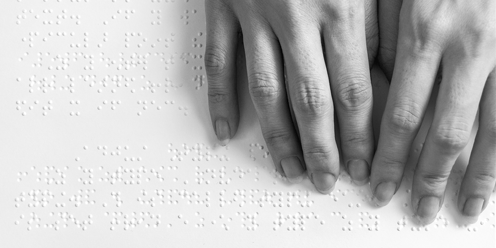Improving communication
Researchers help pioneer ways to enrich lives of visually impaired, An Baijie and Hou Chenchen report.

Blind people in China have been struggling in guessing the meaning of Braille due to its lack of tones. For instance, Mandarin Braille does not have the ability to differentiate between the Chinese words "time" (shijian with jian in the first tone) and "practice" (shijian with jian in the fourth tone) due to identical pronunciations despite the differing tones.
Things have changed as China introduced the Chinese Common Braille Scheme in 2018.
After seven years of research, Zhong Jinghua, a professor at the Special Education College of Beijing Union University, devised a Chinese Braille system capable of representing the tonal aspects inherent in Mandarin.
Zhong's groundbreaking work put an end to the 70-year history of non-tonal Braille in which visually impaired individuals had to guess word meanings.
Now, tonal Braille has been integrated into primary education and Braille publishing, encompassing textbooks used in schools for the visually impaired across China.
Learning advantage
Named after its inventor Louis Braille in 19th century France, Braille is a tactile representation of alphabetic symbols using six dots to represent each letter.
The Braille system commonly used in English-speaking countries may not be suitable for tonal languages spoken in Asia, Africa and the Americas, where over 1.5 billion people use these languages.
China is among the countries requiring an improved Braille system distinct from the standard one. Mandarin Chinese is a tonal language, as the pitch or the tone in which the word is spoken contributes to its meaning.
Similar to many tonal languages worldwide, Mandarin conveys specific meanings but the original Braille system fails to represent its tones.
Braille relies on pinyin, the system for writing Chinese words using the Roman alphabet. A loss of meaning takes place with the conversion from visually based graphic characters to hearing-based phonetic Braille.
Standard Braille's shortcomings may hamper visually impaired students in acquiring knowledge because the absence of tones can result in numerous ambiguities, he says.
The inherent learning potential of visually impaired children is no different from that of other children, according to Zhong, but various factors may impede their learning ability and cause them to lag behind others.
In extensive reading, visually impaired individuals often rely on contextual cues to infer word meanings but this form of inference may be inadequate in learning new knowledge.
"When students come across unfamiliar or new words, grasping their meanings becomes challenging. This leads to numerous difficulties in the learning process," Zhong says.
The traditional Braille system without tone notation was established in 1953. Since then, researchers have continually explored methods to integrate tones into Braille.
In 1988, Huang Nai, a pioneer in China's education for the visually impaired, introduced a two-cell Braille system to address the shortcomings of non-tonal Braille.
"The new system successfully implemented tone notation in two cells, but it overthrew the old Braille system. This required visually impaired individuals to learn an entirely new language, causing them to undergo the pains of Braille reform," Zhong says.
The two-cell system faced many challenges and after a five-year trial period, its use was discontinued.
"In the span of these 20 years dedicated to developing tonal Braille, we've essentially circled back to our starting point," Zhong says.
Overcoming obstacles
The primary challenge in incorporating tones into Braille is to strike a balance between tone accuracy and conserving Braille cells. Any alterations to the Braille system must consider the reading habits of the visually impaired, Zhong says.
"To add tones isn't inherently complex; by introducing an additional six-dot Braille cell to denote tone after the initial and final consonant cells of each character, this can be achieved," he says.
"However, such an approach significantly increases cell amount and drastically slows down reading speed."
From 2007, Zhong started to explore ways to add tones into the Braille system without overturning the original system. In 2009, Zhong's project was launched and received national social science funding.
"Our new version should not overturn the original system; we should consider blind people's reading habits," he says.
Initially, Zhong planned to create a homophone corpus of Mandarin to annotate words in Braille. However, he later abandoned the strategy as it would pose a significant burden of memorization on visually impaired people.
To strike a balance between tone accuracy and conserving Braille cells, Zhong and his group endeavored to omit tone annotation based on tone number or syllables. But these methods did not align with the reading habits of visually impaired individuals, as revealed in their pilot study.
Recognizing the potential to omit annotations by considering the frequency of tone occurrences in the initial consonants of Chinese syllables, Zhong conducted a quantitative analysis of 10 million Mandarin Braille cells. This rigorous examination led Zhong to discover an effective method for incorporating tones into Braille in 2016.
China introduced its Chinese Common Braille Scheme in 2018 following a two-year trial period, marking an end to the 70 years of non-tonal Braille.
To gradually implement the common Braille scheme, textbooks used in schools for the visually impaired were progressively updated with the new scheme starting from the first grade. The common Braille system now encompasses all foundational education from the first to seventh grade in China.
Inclusive education
According to the Seventh National Population Census of China in 2020, there are more than 17 million visually impaired people in the country. Zhong says that both the government and society are increasingly focused on educating this group.
When Zhong began working in education for the visually impaired in the mid-1980s, fewer than 5 percent of children in the group were enrolled in schools. At that time, he was a math teacher at Changle Normal School in East China's Shandong province.
As China began building up its standardized special education, Changle Normal School underwent a major transformation in 1985, becoming the Changle Special Education Normal School. And Zhong became a teacher for the visually impaired.
In 1988, he participated in a sponsored training session by the Caterpillar Foundation in Qingdao, Shandong. He and 32 other graduates became the first standardized teachers for the visually impaired. In 2003, Zhong headed to Beijing Union University and focused on Braille research.
At least 95 percent of visually impaired children now have access to schooling, based on a major program for promoting special education.
"The national social science fund prioritizes special education research projects. Moreover, when our project requires interdisciplinary support, researchers from esteemed institutions like the Chinese Academy of Sciences, Tsinghua University, and Beijing Language and Culture University generously lend their expertise," Zhong says.
Zhong says he will dedicate his life to empowering the visually impaired and expresses the hope for more opportunities for visually impaired individuals to access education and become teachers themselves because they understand the needs of the community.
After completing the tone annotation project, Zhong will focus on word segmentation of Mandarin Braille.
"It is not easy to do one thing well in a short life. My whole life is wrestling with the six dots," Zhong says.




Today's Top News
- Xi taps China's deep wisdom for global good
- New rules aim for platforms' healthy growth
- Chinese web literature grows overseas
- Postgrad exam trend points to thoughtful approach
- World's highest urban wetland a global model
- How China's initiatives are paving a new path to a better world






























